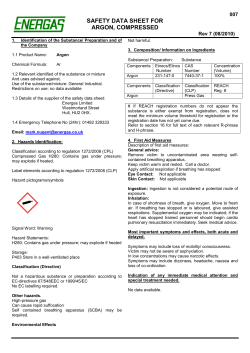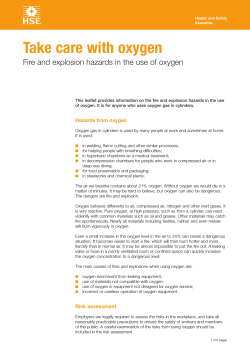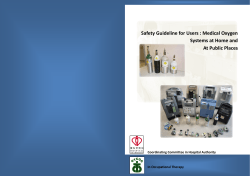
Medical carbon dioxide. Essential safety information. BOC: Living healthcare →
→ Medical Gas Data Sheet (MGDS) Medical carbon dioxide. Essential safety information. BOC: Living healthcare 02 Medical Gas Data Sheet (MGDS) Medical carbon dioxide (SPC) 1. Name of the medicinal product 2. Qualitative and quantitative composition Medical carbon dioxide. Medical carbon dioxide specification is: carbon dioxide purity 99.5% v/v min The medical carbon dioxide cylinder specification complies with the current European Pharmacopeia monograph (0375). 3. Pharmaceutical form Medicinal gas, liquefied. 4. Clinical particulars 4.1 Therapeutic indications 4.2 Posology and method of administration Carbon dioxide is used: •to increase depth of anaesthesia rapidly when volatile agents are being administered. It increases depth of respiration and helps to overcome breathholding and bronchial spasm •to facilitate blind intubation in anaesthetic practice •to facilitate vasodilation and thus lessen the degree of metabolic acidosis during the induction of hypothermia •to increase cerebral blood flow in arteriosclerotic patients undergoing surgery •to stimulate respiration after a period of apnoea •in chronic respiratory obstruction after it has been relieved •to prevent hypocapnia during hyperventilation •for clinical and physiological investigations •in gynaecological investigation for insufflation into fallopian tubes and abdominal cavities •as solid carbon dioxide (dry ice) in tissue freezing techniques and for the destruction of warts by freezing. Carbon dioxide is usually administered through the lungs by inhalation. The major exceptions are when a metered supply is fed into the oxygenator of an extracorporeal circulation of a cardio-pulmonary by-pass system, and when the gas is used for laparoscopic surgery. There are no distinctions between the use of carbon dioxide in any age group. Carbon dioxide should only be given under the direct supervision of a clinician. Except under special circumstances (e.g. physiological investigations), the inspired concentration should not exceed 5%. However, 100% carbon dioxide may be insufflated into the abdominal cavity to distend it to allow the investigation and treatment of intra-abdominal disease, particularly of a gynaecological nature. Reproduction without permission is strictly prohibited © BOC Limited 2014 Medical Gas Data Sheet (MGDS) 4.3 Contraindications 4.4 Special warnings and precautions for use 03 Carbon dioxide is contraindicated: •in acidosis •in respiratory obstruction, the administration of carbon dioxide may be dangerous since any further increase in respiratory effort increases negative intra-thoracic pressure •during resuscitation, where it can be dangerous and should be avoided. Carbon dioxide is stored in high pressure gas cylinders as a liquid under pressure. Rapid opening of the valve can cause the discharged gas to re-liquefy. This liquid can cause cold burns if in contact with the skin. Cylinders should only be used in the vertical position with the valve uppermost. Care is needed in the handling and use of carbon dioxide gas cylinders. 4.5 Interaction with other medicinal products and other forms of interaction Carbon dioxide interacts with anaesthetic agents when the concentration is raised and gives rise to cardiac dysrhythmias. The threshold for dysrhythmias varies with different anaesthetic drugs. Carbon dioxide, by altering pH; influences uptake, distribution and action of many drugs including neuromuscular blocking agents, and hypotensive agents. Carbon dioxide interacts with adrenergic substances such as adrenaline. They should not be used together. 4.6 Pregnancy and lactation 4.7 Effects on ability to drive and use machines 4.8 Undesirable effects 4.9 Overdose The use of carbon dioxide is not recommended in pregnancy but is unlikely to influence lactation. Inhalation of carbon dioxide is not compatible with driving or use of machinery. Carbon dioxide may produce unconsciousness in concentrations over 10%. Cardiac dysrhythmias have been reported in patients undergoing laparoscopy as a result of high blood carbon dioxide levels. Cardiac arrest due to gas embolism has been reported. Moderate overdose of carbon dioxide less than 5% stimulates breathing. If excessive this may cause extreme respiratory difficulty, raise the blood pressure and lead to nausea and vomiting and occasionally unconsciousness. Inconcentrations above 10%, carbon dioxide possesses anaesthetic properties. 5. Pharmacological properties 5.1 Pharmacodynamic properties Pharmacotherapeutic Group: Medical Gases ATC Code: V03AN02 The characteristics of carbon dioxide are: odourless, colourless gas molecular weight 44.00 sublimation point -78.5°C (at 1bar(g)) density 1.872kg/m3 (at 15°C). Carbon dioxide occurs at approximately 350vpm in the atmosphere. The effect of inhaling carbon dioxide, or of its accumulation in the body through breathing defects, varies with the tension achieved in the blood, the duration and condition of the exposure and the susceptibility of the individual concerned. If a normal, conscious individual inhales 5% carbon dioxide, the rate and depth of breathing rise and the minute volume increases 2 to 5 fold. The skin becomes pink and warm and there may be sweating and a sense of discomfort. There is no effect on consciousness or mental function, even with long exposures. After a prolonged exposure, when the return to breathing air takes place, an "off effect" may develop with malaise, pallor, headache and occasional nausea and vomiting, probably due to the metabolic disturbances as a result of breathing a volatile acid. As the inspired concentration rises, these effects become exaggerated in proportion to the concentration. At around 8-9% dizziness may develop, and at 10% some subjects become unconscious. Most people will Reproduction without permission is strictly prohibited © BOC Limited 2014 04 Medical Gas Data Sheet (MGDS) become unconscious at 12.5% and all subjects lose consciousness within 1-2 minutes at 20%. When the concentration is raised to 30% consciousness is lost rapidly, the blood pressure may rise to 27kpa (200mm Hg) or higher and there is intense vasoconstriction, a reduction in heart rate to 40-50 heats per minute and ECG changes. All anaesthetic agents reduce these responses to carbon dioxide. 5.2 Pharmacokinetic properties When inhaled, carbon dioxide is rapidly distributed throughout the body. Physiologically, it regulates the rate and depth of breathing and normally there is a constant tension of 5 kpa (40mm Hg) in arterial blood. The concentration of carbon dioxide in the plasma is three times greater than that in red blood cells. The gas is carried partly in solution (2.4 - 2.7 vol %),but mostly either as bicarbonate (42.9 - 46.7 vol%), or as carbamino compound (3.0 - 3.7 vol%). The relative quantities in solution and as bicarbonate regulate the reaction of the blood and buffer changes in pH produced by stronger organic acids. Carbon dioxide produced by metabolism plays an integral part in the supply of oxygen to the tissues, since the amount released by haemoglobin at any given oxygen tension is directly related to the carbon dioxide tension in the blood. This in turn is governed by tissue activity in the concentration inhaled. Thus the rate at which oxygen is given up to the tissues is increased when the carbon dioxide tension is raised. When a patient becomes apnoeic, carbon dioxide produced in the tissues, accumulates in blood at a rate of about 0.7kpa (5mm Hg) per minute. 5.3 Preclinical safety data None stated. 6. Pharmaceutical particulars 6.1 List of excipients Inert gases. 6.2 Incompatibilities Carbon dioxide should not be given when adrenaline is used. 6.3 Shelf life 6.4 Special precautions for storage 36 months. Carbon dioxide cylinders should be: •stored under cover, preferably inside, kept dry and clean, and not subjected to extremes of heat or cold and away from stocks of combustible material •stored separately from industrial and other non-medical cylinders •stored to maintain separation between full and empty cylinders •used in strict rotation so that cylinders with the earliest filling date are used first •stored separately from other medical cylinders within the store. Warning notices prohibiting smoking and naked lights must be posted clearly in the cylinder storage area and the emergency services should be advised of the location of the cylinder store. Care is needed when handling and using medical carbon dioxide cylinders. Reproduction without permission is strictly prohibited © BOC Limited 2014 Medical Gas Data Sheet (MGDS) 6.5 Nature and contents of container 05 A summary of Medical Carbon Dioxide cylinders, their size and construction, type of valve fitted is detailed below: Cylinder size C E VF LF Gas content (litres) 450 1,800 3,600 3,600 Cylinder construction Steel Steel Steel Steel Valve outlet Pin index Pin index 0.860' x 14 TPI (M) 0.860' x 14 TPI (M) Valve construction Brass Brass Brass Brass Cylinders All cylinders used for the storage of carbon dioxide are manufactured from high tensile steel with a designed working pressure of at least 137bar(g). The colour coding of the shoulders of Medical Carbon Dioxide is grey (RAL 7037). The colour coding of the cylinder body is white (RAL 9010). Cylinders also carry the carbon dioxide name on the body of the cylinder. For a limited period, cylinders may have grey bodies. These cylinders do not have the name carbon dioxide on the body of the cylinder. The programme to convert all Medical Carbon dioxide cylinders to white bodies will be completed by 2025. Cylinder Valves Medical Carbon Dioxide C and E cylinders are fitted with valves with outlet connections that conform to ISO 407 (pin index). LF and VF size cylinders are fitted with outlet connections that conform to BS 341(Type 8) (11/16" x 20 TPI (M)) and are filled with liquid to a specified weight. The pressure in the cylinder is dependant on the vapour pressure at the cylinder temperature. The cylinder valves are constructed from high tensile brass with a steel spindle fitted with a Nylon 6.6 insert. 6.6 Special precautions for disposal and other handling All personnel handling carbon dioxide cylinders should have adequate knowledge of: •properties of the gas •correct operating procedures for the cylinder •precautions and actions to be taken in the event of an emergency. To prepare the cylinder for use: •remove the tamper evident seal and the valve outlet protection cap. Ensure cap, where fitted, is retained so that it can be refitted after use •do not remove and discard any batch labels fitted to the cylinder •ensure that an appropriate regulator is selected for connection to the cylinder •ensure the connecting face on the regulator is clean and the sealing washer fitted is in good condition •connect the regulator, using moderate force only and connect the tubing to the regulator/flowmeter outlet. Only the appropriate regulator should be used for the particular gas concerned •ensure that the cylinder valves and any associated equipment are not lubricated and kept free from oil and grease •open the cylinder valve slowly and check for any leaks. Reproduction without permission is strictly prohibited © BOC Limited 2014 06 Medical Gas Data Sheet (MGDS) Leaks Having connected the regulator or manifold yoke to the cylinder check the connections for leaks using the following procedure: •should leaks occur this will usually be evident by a hissing noise •should a leak occur between the valve outlet and the regulator or manifold yoke, depressurise and remove the fitting and fit an approved sealing washer. •Reconnect the fitting to the valve with moderate force only, fitting a replacement regulator or manifold tailpipe as required •sealing or jointing compounds must never be used to cure a leak •if leak persists, label cylinder and return to BOC. Use of cylinders: When medical carbon dioxide cylinders are in use ensure that they are: •only used for medicinal purposes •turned off, when not in use, using only moderate force to close the valve •only moved with the appropriate size and type of trolley or handling device •handled with care and not knocked violently or allowed to fall •firmly secured to a suitable cylinder support when in use •not allowed to have any markings, labels or batch labels obscured or removed •not used in the vicinity of persons smoking or near naked lights. After use When the medical carbon dioxide cylinders are empty ensure that the: •cylinder valves are closed using moderate force only and the pressure in the regulator or tailpipe released •valve outlet cap, where fitted, is replaced •empty cylinders are immediately returned to an empty cylinder storage area for return to BOC. 7. Marketing authorisation holder BOC Ltd The Priestley Centre 10 Priestley Road The Surrey Research Park GUILDFORD Surrey, GU2 7XY 8. Marketing authorisation number(s) PL 0735/5006R. 9. Date of first authorisation/renewal of the authorisation Date first granted: 01/09/1972. Date of renewal: 23/01/1991. 10. Date of revision of the text 08.11.2013 11. Dosimetry (if applicable) Not applicable. 12. Instructions for preparation of radiopharmaceuticals (if applicable) Not applicable. Reproduction without permission is strictly prohibited © BOC Limited 2014 Medical Gas Data Sheet (MGDS) Notes Reproduction without permission is strictly prohibited © BOC Limited 2014 07 08 Medical Gas Data Sheet (MGDS) Additional Safety Information 1. Contact information 2. Hazards BOC telephone number to be used in the event of an emergency UK 0800 111 333 Classification labelling and packaging regulations Warning. Contains gas under pressure; may explode if heated (H280). Protect from sunlight: store in a well-ventilated place (P410 + P403). Dangerous Preparations Directive Keep out of the reach of children (S2). COMPRESSED GAS 2 Label statements •Asphyxiant in high concentrations. •Contact with liquid can cause frostburns. •No smoking or naked flames in the vicinity of medical carbon dioxide cylinders. •Use no oil or grease. •Keep away from extremes of heat and combustible material. •Store cylinders under cover in a clean, dry and well ventilated area. Medical carbon dioxide is supplied as a liquified gas in a high pressure cylinder. Cylinders may explode if subjected to extremely high temperatures (if involved in a fire). Refrigerated liquefied gas. Contact with product may cause cold burns or frost bite. The gas may cause asphyxiation if inhaled with too low a concentration of oxygen. 3. Fire fighting measures If medical carbon dioxide cylinders are involved in a fire: •if it is safe to move the cylinders, -- close cylinder valve to stop the flow of product -- move cylinders away from source of heat •if it is not safe to move the cylinders, -- cool with water from a protected position. Reproduction without permission is strictly prohibited © BOC Limited 2014 All types of fire extinguishers may be used when dealing with a fire involving medical carbon dioxide cylinders. Fire fighters should use self-contained breathing apparatus when dealing with a fire involving medical carbon dioxide cylinders within a confined space. There are no hazardous combustion products released from the gas. Medical Gas Data Sheet (MGDS) 09 4. Accidental release measures If a large volume of medical carbon dioxide is released, if it is safe to do so, you should close the cylinder valve. If the release continues, evacuate the area and ensure that the affected area is adequately ventilated before re-entry. Self-contained breathing apparatus is required to be used if medical carbon dioxide is released into a confined area without adequate ventilation. 5. Exposure controls When using medical carbon dioxide ensure adequate ventilation. The UK exposure limit for carbon dioxide (as defined in EH40/2005) specifies the Long Term Exposure Level (TWA over 8 hours) should not exceed 5000ppm. A Short Term Exposure level (15- minute reference period) should not exceed 15000ppm. 6. Disposal considerations 7. Transport of cylinders It is recommended that medical carbon dioxide cylinders should not be vented after use – they should be returned to BOC with any residual gas where they will be vented before refilling in a safe environment. If, for safety reasons, a cylinder is required to be vented after use, the gas should be vented to atmosphere in a well ventilated area. Contact BOC if further guidance on venting cylinders is required. When medical carbon dioxide cylinders are required to be transported, ensure that the cylinders are: •located in a compartment separated from the driver •adequately restrained •not leaking and have their valves closed. The vehicle must be adequately ventilated. Ensure the driver is aware of the potential hazards of the load and knows what to do in the event of an accident or an emergency. It is advisable to provide the driver with written instructions that detail the actions to be taken in the event of an accident or emergency. Cylinders should be removed from the vehicle as soon as possible. 8. Transport information Reproduction without permission is strictly prohibited © BOC Limited 2014 UN number Material Labels Hazard identification number Emergency Action Code Tunnel Restriction Code Transport category Carbon dioxide 1013 Class 2 2.2 20 2T E 3 10 Medical Gas Data Sheet (MGDS) Notes Medical Gas Data Sheet (MGDS) Notes 11 The stripe symbol and the letters BOC are registered trade marks of The BOC Group Limited. Both BOC Limited and The BOC Group Limited are members of The Linde Group, the parent company of which is Linde AG. Reproduction without permission is strictly prohibited. © BOC Limited 2014 HLC/506810/BAMC/1213 BOC Healthcare Customer Service Centre, Priestley Road, Worsley, Manchester M28 2UT Tel 0800 111 333, Fax 0800 111 555, bochealthcare-uk@boc.com, www.bochealthcare.co.uk
© Copyright 2025










